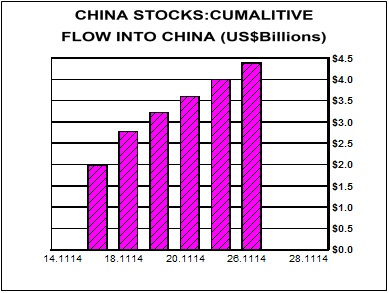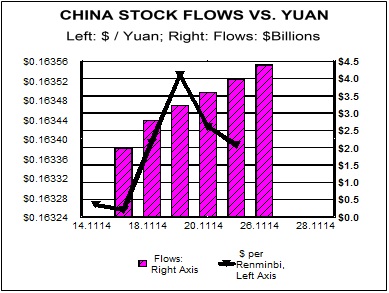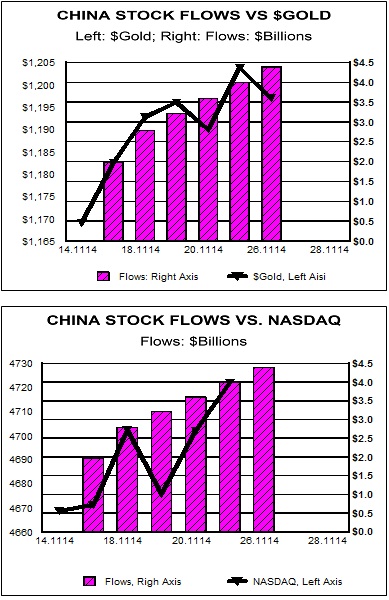China…Follow The Money!

Investors
would be well advised to be aware of the money flowing into the Chinese
stock market, and possible ramifications of that money movement. Money
is like water flowing across the earth, it fills in the low spot. To
foreign investors, and in particular dollar-based institutional funds,
the Chinese stock market is a “low spot” to be filled in with money.
Foreign investors will fill that “low spot” with their money.
Institutional money managers cannot ignore the most important economy in
the world, and one destined to be the largest. As the chart at right
portrays, the cumulative dollar flow into China’s stock market is off to
a good start. At present the daily limitation on investment money
inflow is 13 billion Yuan, or roughly $2.1 billion, per day. Actual
money flows have been below that limit, but it is just the first week of
the rest of time. Note especially that we only have a week of data, and the discussion that follows is about trends that will unfold over time.
 In
order to buy Chinese stocks one must have Renminbi to pay for them. To
a dollar-based investor that means selling dollars and buying Renminbi.
Those transactions should put downward pressure on the dollar and
upward pressure on the Renminbi. While a myriad of factors will
influence the value of the Renminbi, this money flow, which will be
massive over time, will contribute to the secular uptrend in value of
Chinese Renminbi already in place. Second chart above portrays the
cumulative money flows into Chinese stock market with dollar value of
the Renminbi. As that black line is rising, the Chinese currency is
appreciating and the dollar is depreciating. While our focus here is on
the dollar, other currencies, such as the Euro and yen for example, will
come under similar selling pressure.
In
order to buy Chinese stocks one must have Renminbi to pay for them. To
a dollar-based investor that means selling dollars and buying Renminbi.
Those transactions should put downward pressure on the dollar and
upward pressure on the Renminbi. While a myriad of factors will
influence the value of the Renminbi, this money flow, which will be
massive over time, will contribute to the secular uptrend in value of
Chinese Renminbi already in place. Second chart above portrays the
cumulative money flows into Chinese stock market with dollar value of
the Renminbi. As that black line is rising, the Chinese currency is
appreciating and the dollar is depreciating. While our focus here is on
the dollar, other currencies, such as the Euro and yen for example, will
come under similar selling pressure.
As
money flows out of dollars and other currencies, the value of Gold in
those currencies should rise. In the chart to the right is plotted the
cumulative flow of money into Chinese stock versus price of US$Gold.
 Another
question that arises is from where will this money come. Near all the
money flowing into Chinese stocks will come from institutional funds of
all kinds, especially U.S. based speculative funds. While we know not
from where in their portfolios money for purchases of Chinese stocks
will come, one clear candidate for a money source is the NASDAQ traded
issues. Many of those stocks are over owned in institutional portfolios.
In the bottom chart is plotted again the cumulative money flow into
Chinese stocks verus the NASDAQ Composite Index, left axis.
Another
question that arises is from where will this money come. Near all the
money flowing into Chinese stocks will come from institutional funds of
all kinds, especially U.S. based speculative funds. While we know not
from where in their portfolios money for purchases of Chinese stocks
will come, one clear candidate for a money source is the NASDAQ traded
issues. Many of those stocks are over owned in institutional portfolios.
In the bottom chart is plotted again the cumulative money flow into
Chinese stocks verus the NASDAQ Composite Index, left axis.
In
reviewing this situation several possible strategies present themselves
for consideration by investors. With a money flow over coming years
into Chinese stocks that will be measured in the hundreds of billions of
dollar, buying Chinese stocks is clearly one possibility. For a variety
of reasons, this approach may not fit many individual investors. Hong
Kong exchange may be more viable and friendly route.
Second,
consideration should be given to investing in the Chinese Renminbi as
it is likely to rise in value versus your home currency. Most desirable
route is through a Renminbi denominated bank deposit. These accounts are
available through many banks around the world and on the internet. In
U.S. banks those deposits are insured. Exchange Traded Currencies(ETCs),
a form of ETF, are also available. However, investors should probably
avoid Exchange Traded Notes(ETNs).
A
third alternative should be obvious from the above discussion. Gold is a
form of currency that moves opposite the value of national currencies.
Dollar and most other national currencies should depreciate versus the
Chinese Renminbi. That action should add support to the value of Gold in
those currencies. For many, this investment route may be more
comfortable than the previous two.
Finally,
note that the above prognostications are the future, a time period
measured in years. They are not forecasts of what might happen tomorrow
afternoon. We prefer you become wealthier over time rather than feed the
hope for one lucky trade.
********
Ned
W. Schmidt,CFA has had for more than two decades a mission to save
investors from the regular financial crises created by Keynesianism, and
the high priests of that misguided ideology. He is publisher of The Value View Gold Report, monthly, and Trading Thoughts. To receive these reports, go to: www.valueviewgoldreport.com Follow us @vvgoldreport
No comments:
Post a Comment